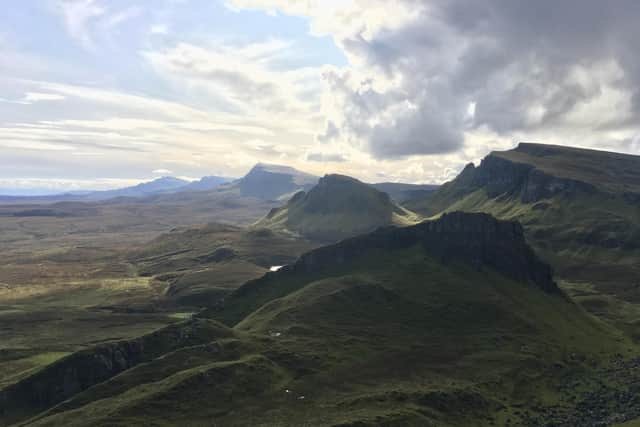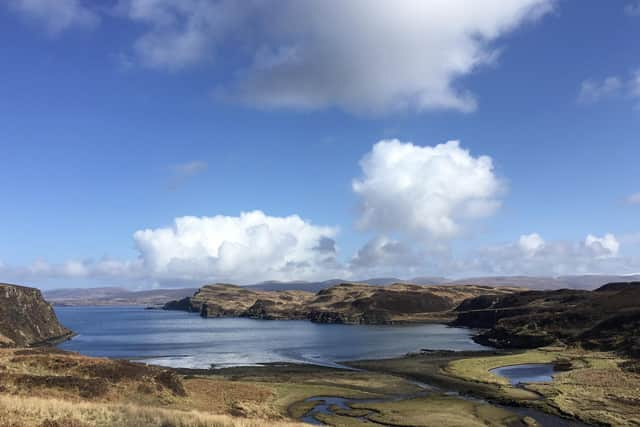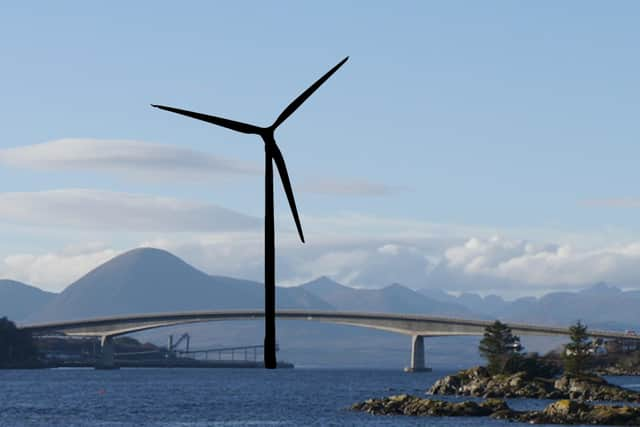Climate change: Should communities have power to veto new wind farms as net zero deadline looms?
They say Scotland’s ambitions to dramatically increase renewable energy – including a target to have 20 gigawatts of onshore wind power installed by 2030 – mean applications for new turbines are being virtually “rubber-stamped”, even in places where high local opposition exists.
A new group has been formed and a petition launched on the Isle of Skye in response to a barrage of plans that could see “industrial-scale” wind farms built across its world-famous rugged landscape.
Advertisement
Hide AdAdvertisement
Hide AdWith the installation of almost 150 new turbines and a major power line currently earmarked for the island, many locals fear there will be “immense” and “permanent” damage to the natural environment, quality of life and important tourism income.
There are currently two operational wind farms on the island – the 12-turbine Ben Aketil, which began generating power in 2009; and 18-turbine Edinbane, operational since 2010.
Both of these are located in broadly the same area.
Between them the two schemes can produce enough electricity to supply the annual needs of 55,000 households – around 10 times the number on Skye.
Now plans have been lodged to build 149 new turbines, standing up to 200m tall – nearly six times the height of the landmark Skye Bridge.


Some of these turbines will be used to “repower” the two existing schemes, replacing the current 100m-tall structures with bigger, more productive ones.
But most are part of completely new developments or extensions spread across the island – a total of seven additional schemes, which together would generate 813 megawatts of electricity.
This is enough to power 970,000 households, or a city twice the size of Glasgow.


Andrew Robinson, who lives in a cottage not far from the operational wind farms, has joined the recently formed Skye Wind Information Group (Swig) – a collective not opposed to wind power but concerned with the type and scale of developments, their impacts and benefits for the area.
Advertisement
Hide AdAdvertisement
Hide AdRobinson and fellow members – more than 1,000 at the last count, and growing – are deeply concerned about the proposals, which they believe would turn Skye into an “energy factory” at the expense of the community and the surroundings they hold so dear.
It’s feared construction work could damage important peatlands, which are crucial for locking up climate-warming carbon and support rare wildlife, and contaminate water supplies, while iconic species such as golden and white-tailed eagles could be harmed by crashes with spinning rotors and miles of power lines and pylons.
On top of these concerns, they say transporting 80m-long turbine blades by lorry across the island will cause untold chaos on roads, which are often narrow and the only route between two places for both locals and tourists alike.


And with hundreds of giant turbines visible for miles around, including from the majestic Cuillin mountains, the scenery which is such a magnet for visitors could be forever blighted.
Robinson, whose home is off-grid and so does not benefit from the power being generated nearby, insists local people need to be much better supported when it comes to developing new renewables schemes and upgrading transmission infrastructure so they can fully understand the implications and make informed decisions.
Swig has launched a petition which calls for a public inquiry into all the planning proposals for wind farms and the new power line to give an overview on the ‘big picture’ for the island.
More than 1,600 people have already signed.
“This would give a chance for a considered debate about the future of energy generation on Skye,” Robinson said.


“It would give disempowered rural communities a chance to speak up.
“A strategic decision needs to be made on all the plans.
Advertisement
Hide AdAdvertisement
Hide Ad“How many wind farms do we want in a place which is famous worldwide for its landscape and beauty?
“Is the Skye Reinforcement Power Line needed if the proposed wind farms are not built?”
The petition also demands a freeze on any further large-scale privately owned wind farms on Skye as well as the set-up of new financial and business support for communities to build their own small-scale wind schemes, which they believe would return a greater income for local people and cause less damage to the local environment.
“Once people do understand what’s planned then the majority are really worried and have many questions,” according to Robinson.
“What will be the impact on tourism, so vital to Skye’s economy?
“Why are islanders not being given free electricity?
“How many of our rare golden eagles and other birds will be killed by collision with the wind farm blades?
“How can each wind farm justify excavating hundreds of thousands of cubic metres of peat, when we have been told we shouldn’t burn peat to heat our homes – a traditional Skye practice – or buy compost containing peat?
“How will traffic on the island cope when the 80m-long blades are being transported night after night from the south of the island to the north-west on huge, abnormal-load convoys, blocking the entire road overnight for more than six months just for one wind farm?”
Advertisement
Hide AdAdvertisement
Hide AdMany islanders also feel that the “tiny amount” of community benefit payments offered by wind farm developers are insulting when compared to the profits the companies will make, and locally owned schemes with fewer, smaller turbines would serve people better.
“Community groups do depend on the small amounts of money they are ‘gifted’ by the developers,” Robinson admits.
“But small-scale community-owned turbines would bring so much more. Such schemes on the Outer Hebrides have been shown to return over 30 times the benefit to local people and projects.”
The view from Skye is echoed by Scots living in many other parts of the country which have been heavily targeted by onshore wind developers.
Scotland’s First Minister Humza Yousaf recently outlined plans to simplify and speed up the consenting process for onshore wind farms as he unveiled the latest Programme for Government.
Aileen Jackson, a member of anti-wind campaign group Scotland Against Spin (SAS), is concerned at the potential impacts of the move.
“The Scottish Government's move to speed up the roll-out of onshore wind will mean less scrutiny of proposals and this will be disastrous for the environment and our rural communities,” she said.
“Hurried decisions are often the wrong decisions.”
The group believes communities are being ignored and have launched a petition calling for planning rules to be changed to be more like the system in England, which will consent only schemes that can “demonstrate local support and address planning impacts identified by the community”.
Advertisement
Hide AdAdvertisement
Hide AdSAS also wants publicly funded legal help and expert assistance for people challenging development plans.
Fellow SAS activist Rachel Conor lives and works on a smallholding in East Ayrshire, near the UK’s largest wind farm, Whitelee, and the smaller Sneddon Law.
“Scottish planning policy is a farce,” she said.
“There is very little point in putting effort into objecting to a development.
“It over-rides local opinion.
“Surely there should be some consideration for people living in rural Scotland and the importance of tourism to many of these places.
“Nobody is going to go there when they are bustling with turbines.
“It’s very short-sighted.
“Even when wind farms are dismantled at the end of their operational lives, hillsides will be left scarred with roads and concrete foundations.”
There’s no doubt that decarbonisation is bringing about a shift in the way energy is generated and used – moving away from large centralised thermal power plants towards smaller-scale, more widely distributed sources, mainly from renewables.
Another thing that cannot be disputed is the urgent need for major upgrades to the electricity network to accommodate the extra capacity which will be required to power the switch to electric cars and eco-friendly heating for homes and businesses.
Advertisement
Hide AdAdvertisement
Hide AdRegardless of how or where it is generated – whether from onshore or offshore wind, solar, tidal, wave or hydro – energy will need to be transported to the places where it will be used.
And this will be a very big and very expensive job, with a wide-scale programme of works to install new cabling and transmission infrastructure that will undoubtedly disrupt daily life and bring long-term changes to landscapes.
This will be carried out by Scottish Power Energy Networks in the south, and by Scottish and Southern Electricity Networks in the north.
“We need to build renewable generation and electricity networks faster than we have ever done before,” said Keith Anderson, chief executive of ScottishPower.
“The two go hand in hand and they both must be done at speed if Scotland is going to reach its 2045 net zero targets.”
As well as enabling the switch to clean energy, decarbonisation will have wider benefits, according Anderson.
And he insists that the concerns of people affected by work will be taken on board.
“This work has the potential to bring a period of green economic growth, providing billions of pounds of investment and thousands of green jobs across Scotland as renewable developers and network owners work to bring about the energy infrastructure that will power Scotland’s homes in the cheapest and greenest way.
Advertisement
Hide AdAdvertisement
Hide Ad“Yes, there will be new, major infrastructure built across Scotland – it’s absolutely crucial that there is.
“But as a responsible neighbour to our communities we will always work to try to find a balance between this necessary infrastructure and listening to what our communities want.”
Comments
Want to join the conversation? Please or to comment on this article.